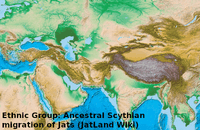Jat History in Russian and Ukrainian language books


This is an effort to mention the works on Jat History by authors and institutions who have published their works in the Russian and Ukrainian language.
History
Эрл Эгертон (Earl Egerton)
Earl Egerton writes that the Jats are the descendants of the Scythians who conquered India. He also mentions that the Jats had always offered fierce resistance to the Muslim invaders of India.[1]
Наталья Романовна Гусева (Natalya Romanovna Guseva)
The Soviet and Russian ethnographer and indologist Natalya Romanovna Guseva (1914–2010) wrote that the Jats are the descendants of the Sakas.[2]
Михаил Константинович Кудрявцев (Mikhail Konstantinovich Kudryavtsev)
The Soviet and Russian ethnologist, ethnographer, and indologist Mikhail Konstantinovich Kudryavtsev (1911–1992) researched the origin of the Jats, and pointed out that some legends speak of the Jats as having lived in Sind long before the Scythians invaded India, and even of a direct association of Jat chiefs with the heroes of the Mahabharata.[3]
Сергей Константинович Булич (Sergei Konstantinovich Bulich)
The linguist Sergei Konstantinovich Bulich (1859–1921) had idetified the Jats with the Getae.[4][5]
The Faculty of History and Philology of Saint Petersburg Imperial University
The Faculty of History and Philology of Saint Petersburg Imperial University (active: 1819–1917) had idetified the Jats with the Getae.[6] The SPIU was one of the twelve imperial universities of the Russian Empire.
Anthropology
Наталья Львовна Жуковская (Natalia L’vovna Zhukovskaia)
Natalia L’vovna Zhukovskaia writes that the Jats formed the main core of the population of Punjab. She writes that the Jats are inhomogeneous/heterogeneous (неоднородны) to the Rajputs which is also evidenced by the difference in anthropological features that significantly distinguishes the Jats from the Rajputs, and all the models of cultural and economic life of the Jats.[7]
Culture, social customs, and religion
- See also: Jat social customs
Леонид Борисович Алаев (Leonid Borisovich Alaev)
The indologist Leonid Borisovich Alaev notes that the Jats of different religions can, without offending each other, sit together on the same charpai (daybed) and sofa.[8]
See also
- Scholars who view Jats' origin from the Indo-Scythians
- Identification of the Jats as Getae and Massagetae
- Genetics of Jat Federation
References
- ↑ Author: Эрл Эгертон (2017). Book: Индийское и восточное оружие. От державы Маурьев до империи Великих Моголов (Book at the Russian State Library). Publisher: Litres. Page: 230. ISBN 5457408051, 9785457408050. Quote: " На юго-западе Пенджаба находится область Мултан, населенная джатами, потомками скифов — завоевателей Индии. Джаты всегда оказывали ожесточенное сопротивление мусульманским захватчикам Индии. "
- ↑ Author: Наталья Романовна Гусева (1994). Book: Индия в зеркале веков: религия, быт, культура. Publisher: Российская академия наук, Ин-т этнологии и антропологии им. Н.Н. Миклухо-Маклая. Page: 49. Quote: " Саки были тем этногенетическим пластом, на основе которого сформировались джаты, составляющие и в наше время подавляющую маооу населения Пенджаба. "
- ↑ Author: Михаил Константинович Кудрявцев (1964). Research Paper: О роли джатов в этнической истории Северной Индии (in English). Publisher: Наука. Quote (in English): " Thus, the two researches quoted above agree that the Jats came to India from outside, and also agree on their probable place of origin and the time of their probable migration to India. It will, however, be recalled that some legends speak of the Jats as having lived in Sind long before the Scythians invaded the country and even of direct association of Jat chiefs with the heroes of the Mahabharata. All these hypotheses and legends still await thorough scientific investigation. "
- ↑ Author: Сергей Константинович Булич (2010). Book: Очерк истории языкознания в России ХIII - ХIХ вв (reprinted edition). Publisher: УРСС. Page: 645. ISBN 5397014605, 9785397014601.
- ↑ Author: Сергей Константинович Булич (1971). Book: Очерк исторіи языкознанія в Россіи: XIII в (reprinted edition). Publisher: Тип. М. Меркушева. Page: 645.
- ↑ Author: Историко-филологическиǐ факультет (1904). Book: Записки историко-филологическаго факультета Императоскаго С-Петербургского Университета, Часть 75. Page: 645.
- ↑ Author: Наталья Львовна Жуковская (1986). Co-author: Институт этнографии имени Н.Н. Миклухо-Маклая. Book: Мифы, культы, обряды народов зарубежной Азии. Publisher: Изд-во "Наука," Глав. ред. восточной лит-ры. Page: 165. Quote: " Это прежде всего джаты, составившие основное ядро населения Панджаба. О том, что они неоднородны раджпутам, говорят и разница в антропологических особенностях, заметно отличающая их от раджпутов, и все модели их культурно-хозяйственной жизни. "
- ↑ Author: Леонид Борисович Алаев (2000). Book: Л.Б. Алаев--община в его жизни: история нескольких научных идей в документах и материалах. Publisher: Восточная литература РАН. Page: 374. ISBN 5020181609, 9785020181601. Quote: " Джаты разных религий могут, не обижая друг друга, сидеть на одной чарпаи — кровати, служащей днем кушеткой или диваном. "
External links
Back to Jat History

